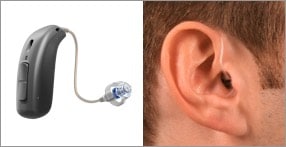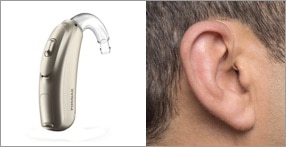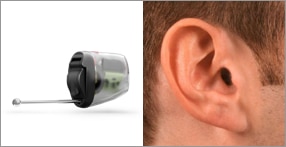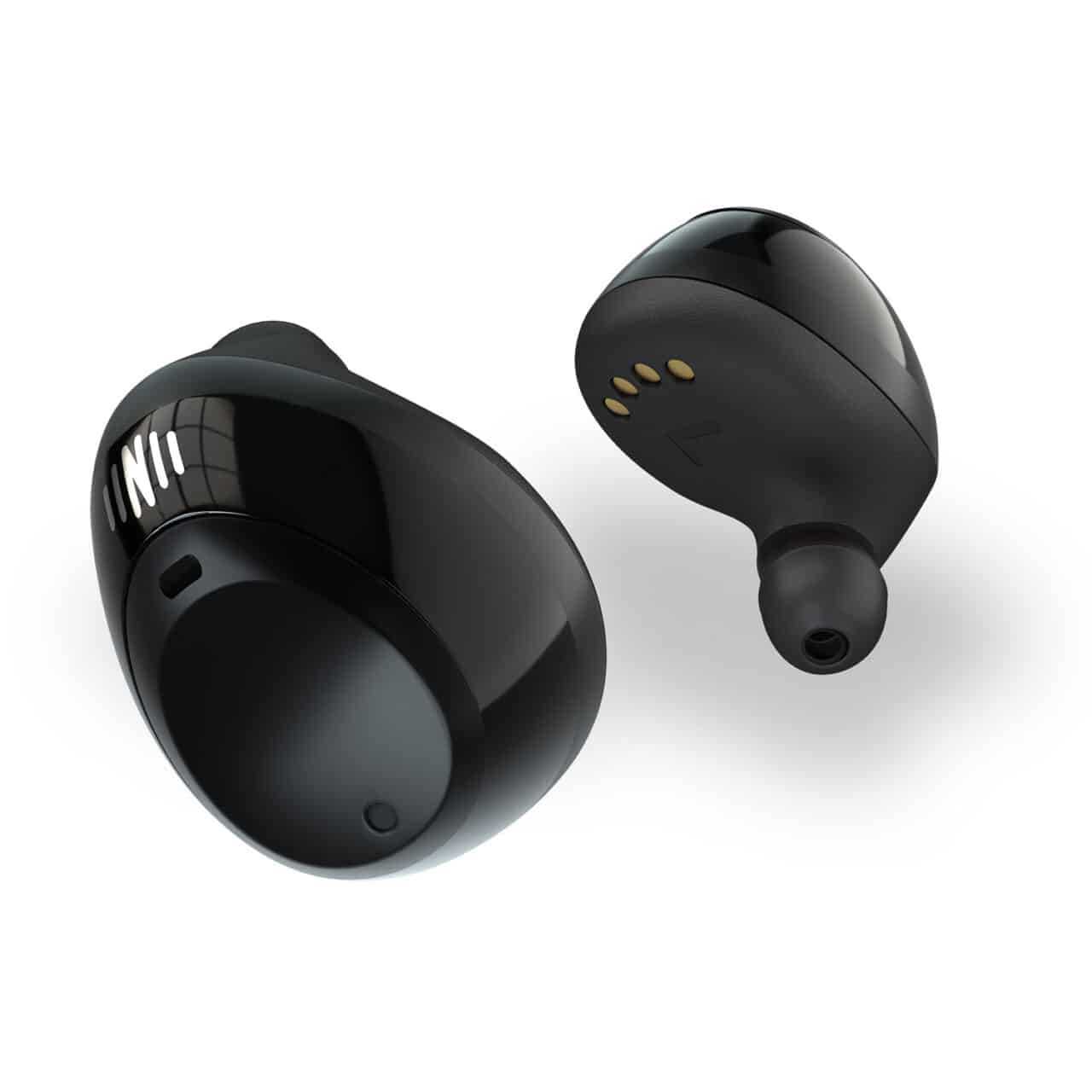Hearing Aid Styles
Hearing aids have improved greatly with the fast changing pace of technology. Your audiologist will help guide you in selecting a hearing aid style and technology level most appropriate for your lifestyle and communication needs.
Here are the types available:
Receiver-in-the-Canal (RIC)

A RIC hearing aid consists of a tiny housing containing all electronics except the receiver, positioned behind the ear. A thin tube connects the housing to the receiver, which is worn in the ear canal.
The RIC hearing aid is a small and discreet unit which is flexible enough to treat mild to significant hearing loss.
Behind-the-Ear (BTE)

A BTE device rests directly behind the ear. The housing, which contains all of the electronics, is encased in plastic and connects to the ear canal with a clear tube generally connected to a custom ear mold.
Though more visible than other styles, the BTE is powerful enough for severe to profound hearing losses.
Invisible-in-Canal (IIC)

This hearing aid is the smallest available hearing aid and sits deeply into the ear canal. This allows the hearing aid to take advantage of the ear’s natural ability to collect sound, and its discreet size makes the device virtually invisible to others.
Due to its smaller size, this hearing aid generally has a shorter battery life, and it may prove difficult to adjust for those with poor manual dexterity. This is a good choice for mild to moderate hearing loss.
Completely-in-the-Canal (CIC)

This hearing aid is placed in the ear canal. It takes advantage of the ear’s natural ability to collect sound. Its discreet size makes the device virtually invisible to others.
Due to its smaller size, this hearing aid generally has a shorter battery life, and it may prove difficult to adjust for those with poor manual dexterity. This is a good choice for mild to moderate hearing loss.
Over the Counter Hearing Aids

If you’ve heard of over-the-counter (OTC) hearing aids, then you may have also heard you don’t need a prescription to purchase them. OTC devices can function as a self-serve option and are now available.
Hearing Aids: Frequently Asked Questions
These answers are intended to provide general guidance. For personalized advice, please consult with one of our ENT specialists.
Which is currently the most popular style of hearing aid?
The best type of hearing aid depends on the patient’s degree of hearing loss. For those with moderate to profound hearing loss, behind-the-ear models are best. For patients with mild to moderate hearing loss, in-the-canal or completely-in-the-canal devices offer amplification with a more discreet appearance.
What is the most discreet hearing aid?
Invisible-in-the-canal hearing aids are the most discreet option available. They fit entirely inside the ear canal and can be easily inserted or removed using a small pull cord.
How can I hide my hearing aid?
While your hearing aids are nothing to be ashamed of, you can opt for more discreet options like in-the-canal or skin-toned behind-the-ear models if you’re concerned about appearance.
Can I get a hearing aid without an audiologist?
You can purchase over-the-counter (OTC) hearing aids without the help of an audiologist, but they’re not right for everyone. Prescription hearing aids ensure the best fit and sound quality. Audiologists fit and program hearing aids to match your needs and offer ongoing support for maintenance, troubleshooting and changes in your hearing.
Hearing Aid Technology: Frequently Asked Questions
These answers are intended to provide general guidance. For personalized advice, please consult with one of our ENT specialists.
What is the newest technology for hearing aids?
Newer hearing aid models offer tinnitus relief, health and fitness tracking and advanced AI features like directional microphones, noise cancellation and real-time environmental adaptability. They also deliver more natural sound quality and learn your preferences over time to adjust to your needs automatically.
What is a Bluetooth®-enabled hearing aid?
Bluetooth-enabled hearing aids wirelessly connect to compatible devices like smartphones, tablets, TVs and computers.
Can you talk on the phone with Bluetooth hearing aids?
Yes. Bluetooth-enabled hearing aids connect seamlessly with your phone, allowing you to stream calls, music and more right to your devices.
Can I listen to the TV with Bluetooth hearing aids?
Your Bluetooth-enabled hearing aids can connect to any smart TV equipped with Bluetooth. Check your TV’s manual if you’re unsure whether it’s Bluetooth compatible.
Call Midwest Hearing at (651) 702-0750 for more information or to schedule an appointment.
